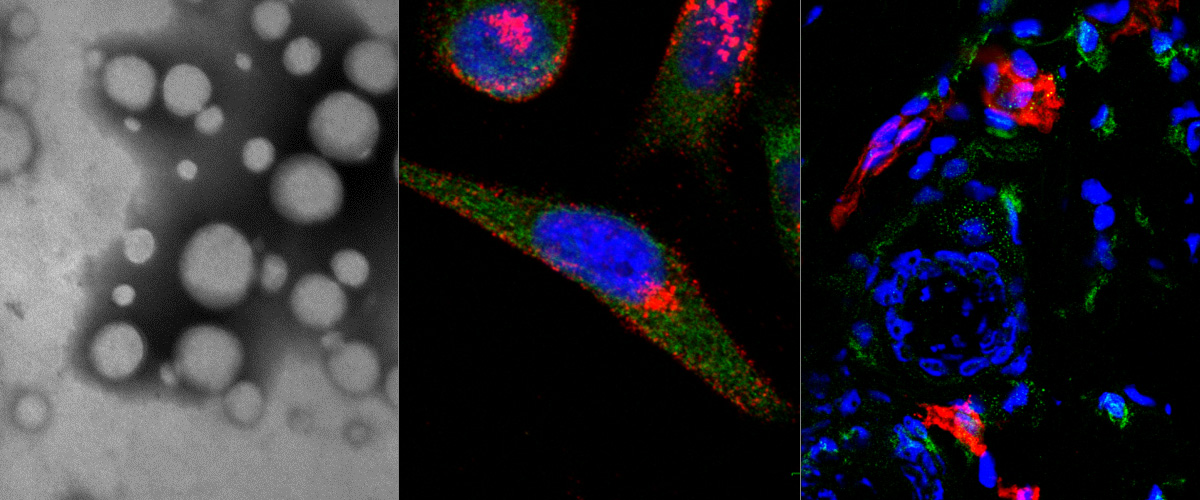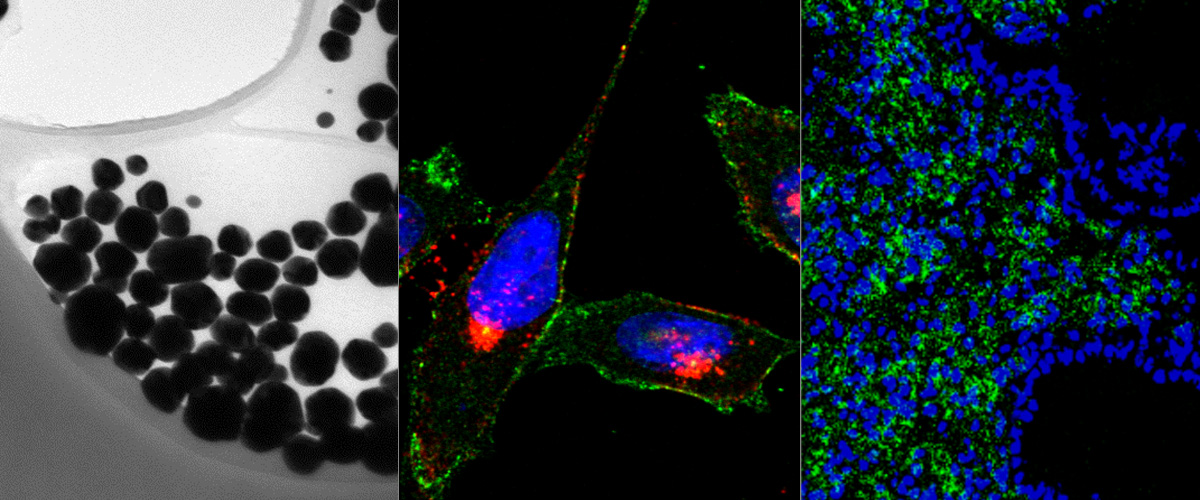Dual-peptide Functionalized Acetalated Dextran-Based Nanoparticles for Sequential Targeting of Macrophages During Myocardial Infarction
Torrieri G, Fontana F, Figueiredo P, Liu Z, Ferreira MPA, Talman V, Martins JP, Fusciello M, Moslova K, Teesalu T, Cerullo V, Hirvonen J, Ruskoaho H, Balasubramanian V, Santos HA.
Nanoscale. 2020 Jan 28;12(4):2350-2358. doi: 10.1039/c9nr09934d. Epub 2020 Jan 13. PMID: 31930241
Hierarchical Nanostructuring of Porous Silicon With Electrochemical and Regenerative Electroless Etching
Mäkilä E, Anton Willmore AM, Yu H, Irri M, Aindow M, Teesalu T, Canham LT, Kolasinski KW, Salonen J.
ACS Nano. 2019 Nov 26;13(11):13056-13064. doi: 10.1021/acsnano.9b05740. Epub 2019 Nov
Collaborative reports with Prof. Santos and Prof. Salonen in Finland and Prof. Mougdil in the USA.
Collaborative studies in interdisciplinary fields, such as nanomedicine, are critical for developing synergies and robust translationally relevant platforms.
Recently, our team participated in highly rewarding and productive collaborative research efforts with the research groups of Prof. Hélder Santos (on myocardial infarction targeting), Prof. Jarno Salonen (on development of novel hierarchically structured silicon nanoparticles) and Prof. Kamal Mougdil (on development of novel homing peptide that targets demyelinating neuroinflammatory lesions in brain). In these interdisciplinary studies, our researchers contributed their expertise in development of advanced peptidic targeting ligands and nanocarriers. We look forward for future successful joint research endeavors!
- Torrieri G, Fontana F, Figueiredo P, Liu Z, Ferreira MPA, Talman V, Martins JP, Fusciello M, Moslova K, Teesalu T, Cerullo V, Hirvonen J, Ruskoaho H, Balasubramanian V, Santos HA. Dual-peptide functionalized acetalated dextran-based nanoparticles for sequential targeting of macrophages during myocardial infarction. Nanoscale. 2020 Jan 28;12(4):2350-2358. https://pubmed.ncbi.nlm.nih.gov/31930241
- Mäkilä E, Anton Willmore AM, Yu H, Irri M, Aindow M, Teesalu T, Canham LT, Kolasinski KW, Salonen J. Hierarchical Nanostructuring of Porous Silicon with Electrochemical and Regenerative Electroless Etching. ACS Nano. 2019 Nov 26;13(11):13056-13064. https://pubmed.ncbi.nlm.nih.gov/31670505
- Acharya B, Meka RR, Venkatesha SH, Lees JR, Teesalu T, Moudgil KD. A novel CNS-homing peptide for targeting neuroinflammatory lesions in experimental autoimmune encephalomyelitis. Mol Cell Probes. 2020 Jun;51:101530. https://pubmed.ncbi.nlm.nih.gov/32035108
CendR peptide for Tenascin-C C domain isoform targeting.
We describe in Scientific Reports a new homing peptide that interacts with the C-isoform of Tenascin-C (TNC-C) upregulated in malignant tissues and is capable of interacting via its C-end Rule (CendR) motif with cell-and tissue penetration receptor neuropilin-1 (NRP-1). We found that coating nanoparticles with PL3 peptide increased their tropism towards glioblastoma (GBM) and prostate carcinoma xenograft lesions in nude mice. Furthermore, treatment of glioma-bearing mice with proapoptotic PL3-guided NWs improved the survival of the mice, whereas treatment with untargeted particles had no effect. Importantly, PL3-coated nanoparticles accumulated in TNC-C and NRP-1-positive areas in clinical tumor samples, suggesting a translational relevance.
This work was performed in collaboration with the Department of Neurosurgery of Tartu University Clinics and Prof. Rolf Bjerkvig at the University of Bergen.
Lingasamy P, Tobi A, Kurm K, Kopanchuk S, Sudakov A, Salumäe M, Rätsep T,Asser T, Bjerkvig R, Teesalu T. Tumor-penetrating peptide for systemic targeting of Tenascin-C. Sci Rep. 2020 Apr 2;10(1):5809. DOI: 10.1038/s41598-020-62760-y
https://pubmed.ncbi.nlm.nih.gov/32242067
mUNO peptide targets M2-TAMs in primary and metastatic breast tumors.
Our collaborative study, published in Molecular Pharmaceutics describes the application of a short linear peptide (CSPGAK, "m(ini)UNO") for the delivery of molecular and nanoscale cargoes in M2-like tumor associated macrophages in vitro and the relevance of the peptide for in vivo targeting of early-stage primary breast tumors and metastatic lung foci.
This important study provides additional mechanistic understanding of mUNO binding and internalization pathway, addresses the effect of route of administration on the peptide bioavailability, and shows the robust accumulation of mUNO in M2-skewed macrophages in mouse models of early primary breast tumor and lung metastasis. This work also illustrates that mUNO can serve as a diagnostic probe for metastatic dissemination, by guiding an imaging agent to M2 macrophages in tumor and lymph node, more sensitively than an established tumor lymph node targeting agent.These studies support application of mUNO peptide for delivery of molecular and nanoscale cargoes to M2 macrophages in primary and metastatic breast tumors.
Lepland A, Asciutto EK, Malfanti A, Simón-Gracia L, Sidorenko V, Vicent MJ, Teesalu T, Scodeller P. Targeting Pro-Tumoral Macrophages in Early Primary and Metastatic Breast Tumors with the CD206-Binding mUNO Peptide. Mol Pharm. 2020 Jun 1. doi: 10.1021/acs.molpharmaceut.0c00226
https://pubmed.ncbi.nlm.nih.gov/32421341
Congratulations to our 1st year PhD students !
Recently, the work of all our three first-year Ph.D. students was recognized by prestigious awards:
Valeria Sidorenko, MSc
First prize for the MSc thesis entitled "Peptide-targeted polymersomes for cancer therapy and detection" in the Estonian National Contest for University Students, in the field of Health Research. Thesis supervisors: Dr. Lorena Simon Gracia, Prof. Tambet Teesalu.
Kristina Põšnograjeva, MSc
First prize for the MSc thesis entitled "MAL clusters and proteins of yeasts with emphasis on α-glucosidases of Scheffersomyces stipitis" in the Estonian National Contest for University Students, in the field of Bio and Environmental Sciences. This work was done under supervision of Ass. Prof. Tiina Alamäe.
Anni Lepland, MSc
Award from the Liisa Kolumbus Memorial Foundation for professional development.
Diploma in the Estonian National Contest for University Students, in the field of Bio and Environmental Sciences. Thesis supervisors: Dr. Pablo Scodeller and Prof. Tambet Teesalu.
Congratulations to all and keep up good work!!!
Talk of Prof. Teesalu at Sanford Burnham Prebys Medical Discovery Institute
On Oc. 30th Prof. Teesalu gave a Cancer Center lecture series talk “Tumor homing peptides: discovery and applications for precision drug delivery” at Fishman auditorium of the SBP La Jolla campus. The talk was preceded and followed by meetings with the SBP faculty members to discuss strategies on using tumor- and central nervous system homing peptides for development of precision drugs to treat cancer and neurodegenerative diseases.
Bi-specific tenascin-C and fibronectin targeted peptide for solid tumor delivery
Lingasamy P, Tobi A, Haugas M, Hunt H, Paiste P, Asser T, Rätsep T, Kotamraju VR, Bjerkvig R, Teesalu T.
Biomaterials. 2019 Oct;219:119373. doi: 10.1016/j.biomaterials.2019.119373. Epub 2019 Jul 19.
PL1: a bispecific peptide that targets extracellular matrix in solid tumors
We report in Biomaterials the identification and development of a novel homing (affinity targeting) peptide that interacts with two landmark proteins in the extracellular matrix of solid tumors: oncofetal fibronectin extra domain B (FN-EDB) and tenascin-C C domain (TNC-C).
We used peptide phage biopanning to identify a 12-mer targeting peptide (PL1, sequence: PPRRGLIKLKTS) that selectively interacts with both TNC-C and FN-EDB. We showed that PL1-functionalized iron oxide nanoworms and silver nanoparticles home to glioblastoma and prostate carcinoma xenografts and to intradermal angiogenic neovessels induced by VEGF-driving adenovirus. PL-1 targeting can be used to improve therapeutic index of anticancer payloads - treatment of glioblastoma-bearing mice with proapoptotic PL1-functionalized nanoparticles resulted in significant reduction of tumor volume and increased survival. Importantly, PL-1 peptide nanoparticles interacted with TNC-C and FN-EDB-positive areas of cryosections of clinical glioma samples. This study suggests that PL1 peptide may have applications as a specific affinity ligand for targeted delivery of diagnostic and therapeutic compounds to solid tumors. EDB antibodies against FN-EDB and TNC-C are in clinical trials as carriers of cytokines to solid tumors, targeting of cancer with a bispecific peptide may allow for a simpler system and more uniform and robust tumor delivery than can be achieved with monospecific antibodies.
This work was performed in collaboration with the Department of Neurosurgery of Tartu University Clinics and Prof. Rolf Bjerkvig at the University of Bergen.
Link to the abstract of the publication: https://www.ncbi.nlm.nih.gov/pubmed/31374479
Elsevier open access link: https://www.sciencedirect.com/science/article/pii/S0142961219304727?via%3Dihub
PL1 IP is owned by the University of Tartu and is available for licensing.
Image: Lead author of the publication, Prakash Lingasamy (left) and Prof. Tambet Teesalu (right). Photograph: Allan Tobi.
LinTT1 tumor penetrating peptide guided nanoparticles for improved imaging and therapy of glioblastoma
In a collaborative study “Peptide-guided nanoparticles for glioblastoma targeting” published in Journal of Controlled Release we evaluated a novel tumor penetrating peptide that targets cell surface p32, LinTT1 (AKRGARSTA), as a GBM targeting ligand for systemically-administered nanoparticles. LinTT1-functionalization increased tumor homing of iron oxide nanoworms (NWs) across a panel of five GBM models ranging from infiltratively-disseminating to angiogenic phenotypes. LinTT1-NWs homed to CD31-positive tumor blood vessels, including to transdifferentiated endothelial cells, and showed co-localization with tumor macrophages and lymphatic vessels. LinTT1-guided proapoptotic NWs exerted strong anti-glioma activity in two models of GBM, including doubling the lifespan of the mice in an aggressive orthotopic stem cell-like GBM that recapitulates the histological hallmarks of human GBM.
Lead authors of this exciting and potentially translationally relevant study were Pille Säälik and Prakash Lingasamy (both Laboratory of Cancer Biology). This work was performed in collaboration with the Department of Neurosurgery of Tartu University Clinics, team of Dr. Dinorah Friedmann-Morvinski at Tel Aviv University, and Prof. Rolf Bjerkvig at the University of Bergen.
Link to the abstract of the paper: https://www.ncbi.nlm.nih.gov/pubmed/31255690



